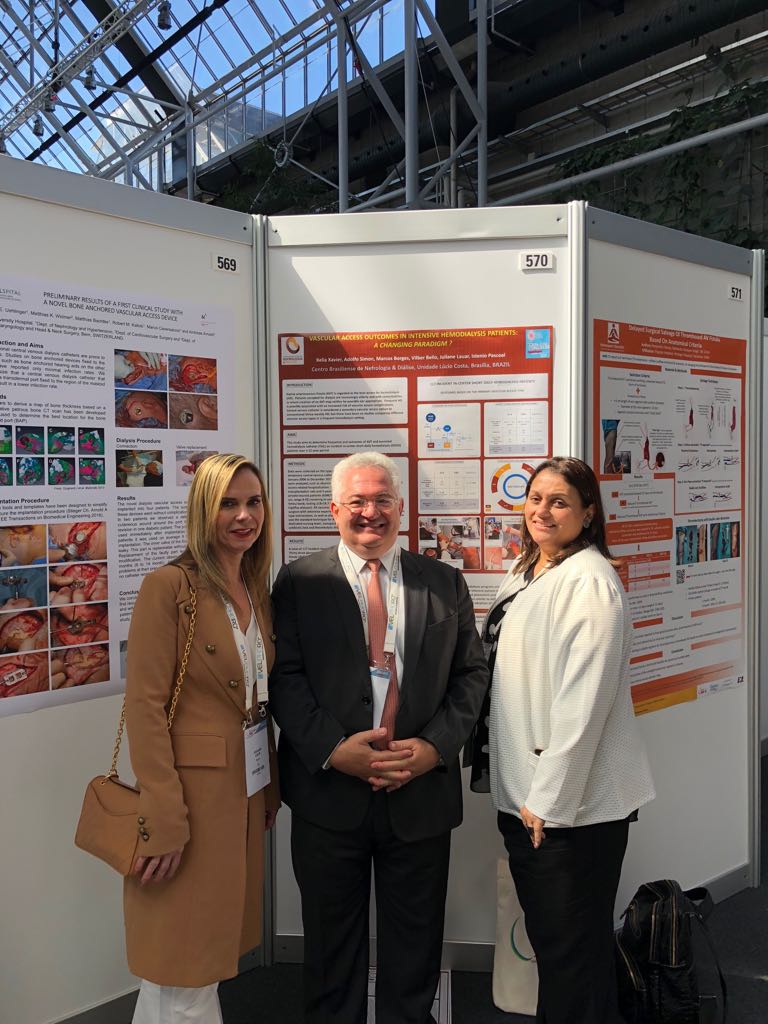Tunneled Hemodialysis Catheter is similar to Arteriovenous Fistula for Intensive Maintenance Hemodialysis, says study presented in Copenhagen at the ERA-EDTA 2018 Congress
Copenhagen, Denmark, May 25 2018 --- Patients accepted for dialysis are increasingly elderly and with comorbidities, in whom creation of an arteriovenous fistula (AVF), regarded as the best vascular access for hemodialysis (HD), may neither be possible nor appropriate. Frequent HD is possibly associated with an increased risk of AVF complications. Central venous catheter has always been considered an inferior vascular access option to conventional thrice-weekly HD, but there have been no studies comparing different vascular access types in a frequent hemodialysis setting.
To address this issue, a team of nephrologists from Centro Brasiliense de Nefrologia & Diálise (CBN&D), Brasília, Brazil, presented today, at the ERA-EDTA 2018 Congress, results of their study to determine frequency and outcomes of AVF and tunneled hemodialysis catheter (THC) on incident in-center short daily hemodialysis (SDHD) patients over a 12-year period.
According to Dr. Kelia Xavier, the study lead author, the data were collected on the type of access used for first HD, including AVF, THC, temporary central venous catheter (tCVC) or arteriovenous graft (AVG) from January 2006 to December 2017. "Comparative outcomes between AVF and THC were analyzed, such as absence of access dysfunction, access-related infection and access-related hospitalization. Information was also gathered on cumulative transplantation rate and 5-year actuarial survival of 117 consecutive unselected private-insured patients (63M/54F; mean age at dialysis initiation was 57.8+20.7 yrs, range 8-92) receiving in-center short daily hemodialysis treatments (6-7 times/week; lasting 118+18.7 min, range 90-180; ultrapure dialysate and single-use high-flux dialyzer)", said Dr. Xavier.
All vascular procedures were done by an associated vascular surgeon with extensive experience in determining eligibility for hemodialysis access type and location, as well as placement and follow up care. Buttonhole cannulation was the standard technique for AVF punctures, while THC use protocol included dedicated nursing team, transparent dressing, closed connector device and use of antibiotic lock and thrombolytic drugs whenever needed.
A total of 117 incident short daily hemodialysis patients were enrolled in the study. Thirty-three percent (39/117) were first dialyzed through a mature arteriovenous fistula (AVF), while 67% (78/117) required an internal jugular catheter for starting HD - 40% THC and 27% tCVC. No patients used AVG.
There was a trend of THC users at dialysis initiation to be older (63.8+22.9 vs 55.4+18.1 yrs, p=0.069), diabetic (38% vs 28%, p=0.334) and less likely to get transplanted (15% vs 32% cumulative kidney transplantation rate, p=0.064), whilst having a significantly lower cumulative 5-year survival (45% vs 74%, p=0.007) when compared to AVF users. Over the 12-year study period 53% of AVF and 47% of THC needed no repair, replacement or modality shift (p=0.585). Access local or exit site infection rates were 0.49 and 0.81 events per 1,000 patient- and catheter-days in AVF and THC users (p=0.077) and bacteremia rates were 0.27 and 0.47 events per 1,000 patient- and catheter-days, respectively (p=0.130).
"In our in-center short daily hemodialysis program using the vascular access up to twice as often, in spite of adverse underlying patient characteristics starting hemodialysis with THC, under strict placement and maintenance protocols, has provided long-term access outcomes similar to AVF. Vascular access may no longer be a barrier for enhancing universal adoption of intensive HD", said Dr. Xavier
Dr. Juliane Lauar, CBN&D Medical Director and study co-author, said: "Our pre-dialysis interdisciplinary care modulates the primary vascular access option for all patients commencing in-center SDHD. Overall, 73% initiated their first dialysis treatment with a permanent vascular access (33% AVF, 40% THC). On intensive maintenance hemodialysis, the mean prevalence rate over the years has been around 50% of both AVF and THC".
Daily hemodialysis, a growing intensive dialysis modality, increases the number of AVF cannulations per week and overall stress on the access and has been associated with higher incidence of complications when compared with thrice-weekly schedule.
Dr. Istenio Pascoal, CBN&D Administrative Director and also co-author, said: "While daily punctures may be harmful to AVF structure and function, THC outcomes may be benefited by daily inspection, rinse and lock renewal. In consistency with this assertion, our 12-year in-center SDHD experience, under strict protocols for nursing care and proper management, shows no differences in access outcomes between AVF and THC users. Thus, THC may represent a suitable dialysis access option for intensive hemodialysis treatment".
Contact author Dr. Kelia R. Xavier: Este endereço de email está sendo protegido de spambots. Você precisa do JavaScript ativado para vê-lo.
Vascular Access Outcomes in Intensive Hemodialysis Patients: A Changing Paradigm? Presenting authors: Dr. Juliane Lauar (left), Dr. Istenio Pascoal and Dr. Kelia Xavier (right)
Presenting authors: Dr. Juliane Lauar (left), Dr. Istenio Pascoal and Dr. Kelia Xavier (right)





